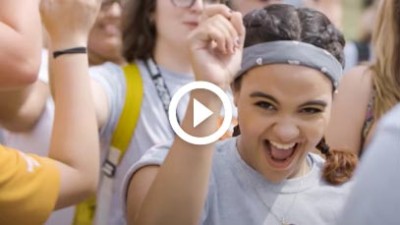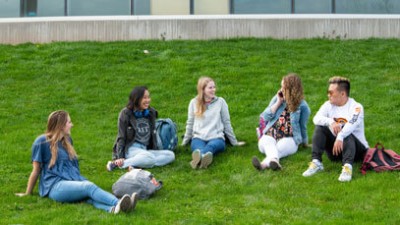Visual Culture Immersion - Curriculum
Visual Culture Immersion
| Course | |
|---|---|
| Electives | |
| Choose three of the following: | |
| COMM-240 | Media, Creativity, and Innovation |
| FNRT-370 | American Painting* A survey of the style and meaning in American paintings from the colonial limners, through the 19th and 20th centuries, to contemporary artists. It centers on what distinguishes painting of the colonies and of the United States from the European counterpart. Lecture 3 (Fall). |
| MUSE-220 | Introduction to Museums & Collecting This course examines the history, theory, and practice of museums by situating them as social institutions emerging within their broader historical and cultural contexts, from their origins in the mouseion of the classical era and Renaissance cabinets of curiosities to the modern era’s World’s Fairs and museums of today. The evolution and range of museum functions are addressed. Building on these foundations, the following types of museums and institutions are explored: art and design, natural history, anthropology, science, and history museums, as well as historic houses and sites, botanical gardens, and zoos. In studying the histories and functions of museums through the lenses of social institutions, the course highlights the evolution of museums institutionally, ideologically, and experientially. The course considers the operations of museums, governance, and the professional ethics and legal constraints that affect museum professionals; examines museums and their practices through the perspectives of colonialism and de-colonialization, nationalism, class, gender, ethnicity, anti-racism, and community; and includes field trips to local institutions and on-campus site visits throughout the semester. Lecture 3 (Fall). |
| MUSE-225 | Museums & the Digital Age The digital revolution has profoundly influenced how we think about the world around us. Information once available only to experts is now accessible digitally to a much broader audience. Museums, archives, and libraries have adapted to this democratization of knowledge and decentralization of access in myriad ways. As visitors to museums—whether online or onsite—each of us is part of the creation, consumption, and reception of digital information. What does this mean for museums and for us as audiences and consumers of such information? How has the combination of digital technology and social media increased visitors’ abilities for interaction with cultural institutions, their collections, and other visitors? This course will examine the history and evolution of museum practices as they adapt to new technologies and rethink traditional museum practices. The course has no pre-requisite and is open to students of all majors. Lecture 3 (Fall). |
| MUSE-360 | Visitor Engagement & Museum Technologies All of us, as museum visitors, have the capacity to engage with collections and to create meanings as a result of such interaction. This course considers the history and theory of visitor engagement at museums, galleries, and sites of cultural heritage tourism; examines the import of technology into this history; and articulates the role of visitors as participants who curate their own experiences. Two key questions will be addressed in this course: 1) How does technology provide a platform for contribution, collaboration, co-creation, and co-opting of experiences among all visitors? and 2) Can technology mediate the best possible experience for visitors? The course has no prerequisite and is open to students of all majors. Lecture 3 (Spring). |
| VISL-206 | Queer Looks In this course we examine representations of queer sexuality in art, film and popular culture beginning in the repressive 1950s, followed by the Stonewall Riots of 1969. We situate the birth of gay liberation in the U.S. in the context of the civil rights struggles, feminism and the anti-war movement. We turn to the work of Andy Warhol that looms over the post-war period, challenged subsequently by the onset of AIDS and the work of General Idea and Act-Up, on the one hand, and the more graphically provocative work of Robert Mapplethorpe, on the other. We examine the diversification of the queer community as transgendered identity asserts itself and the opening of popular culture to issues of diverse sexual identities. We explore expressions of queer sensibility outside of North America and Europe. We turn finally to the issue of gay marriage, both in the U.S. and abroad. Lecture 3 (Spring). |
| VISL-224 | History & Theory of Exhibitions |
| VISL-295 | Global Craftivism, Gender and Handwork The course focuses on how traditionally feminine and domestic handcrafts have been thrust into the public sphere for social activist work in a highly visual manner. Students will examine, from both intellectual and practical perspectives, large-scale examples of craft activism both within the U.S. and internationally, focusing on the connections to political movements and how craft is made politically visual. The role of craft as an organizing force, typically enacted by women and gender minorities in situations of physical and personal vulnerability, will be investigated through readings centered on the historical ties of craft to activism and social reform in the U.S. For example, students will study the role of handwork in the Suffragist and Abolitionist movements and in the American Revolution with women’s use of “homespun” cloth. Attention will also be paid to the NAMES Project AIDS Memorial Quilt in the late 20th century. Expanding beyond the U.S., the course will analyze how craft can transform into a narrative of personal or communal identity and an ethnicity-preserving tool through case studies such as those from Chile (Arpilleras), Laos (Hmong story cloths), Argentina (Mothers of the Plaza de Mayo kerchiefs), India (Khadi cloth), England (Greenwich Commons Women’s Peace Camp and quilts), and Myanmar (street crochet for Democracy). Close attention will also be paid to the role of handcraft as a rallying force in organizing efforts relating to current issues such as reproductive justice, women’s rights, racial justice, LGBTQIA+ rights, climate and environmental justice, and to how craft activist campaigns are organized and disseminated through social media. During the course, students will work at transforming a contemporary social issue they care about into the theme of their own final project to be unveiled by the end of the semester. Lecture 3 (Fall or Spring). |
| VISL-310 | Media Production Lab In this tech-forward environment, students will gain hands-on media-production experience and exposure to innovative technologies to enhance their storytelling and media capabilities. Students will develop a project, business plan (where appropriate) and pitch for entry in campus competitions, and will learn how to concisely “sell” their innovative media ideas, and prototype, in a succinct and compelling way to possible funders. Students will also learn how to navigate funding opportunities that are internal to and external to RIT, how to identify gaps in the media-production landscape, and how to make themselves distinct from competitors. At the end of the course, students will have produced, and pitched, their own innovative media project ready for competition. Lec/Lab 3 (Fall or Spring). |
| VISL-320 | Contemporary Cinema: Fact and Fiction We will study cinema in the United States and abroad from the mid-20th century to contemporary screen cultures. We will consider shorts, war documentaries, biographical and autobiographical films, animation, mockumentaries, video diaries, and immersive installations. Questions we will ask include: How does cinema represent or transform social and historical events in local and global contexts? Which ethical and aesthetic responsibilities does a filmmaker have to their audience and filmed subjects? What ethical questions do the films raise for us as spectators? How do we understand the role of media technologies in the making of these films? We will investigate the structures, techniques, and ideologies that identify cinematic practices as fiction or non-fiction and consider films that challenge these representational systems, helping us examine the line between fact and fiction. Students will complete a film critique as a class assignment. Lecture 3 (Fall or Spring). |
| VISL-372 | American Film of the Studio Era This course examines the history and aesthetics of the motion picture in the United States between the 1890s and the early 1960s; emphasis will be placed on the analysis of both the work of major American filmmakers and the development of major American film genres during the Classical Hollywood Studio period. Among the filmmakers to be studied are Griffith, Chaplin, Hawks, Ford, Capra, Welles, Curtiz, Wilder, Donen, Sirk, Ray, Hitchcock, and Kubrick. Genres to be covered include the melodrama, silent comedy, screwball comedy, western, thriller, film noir, newspaper film, and the gangster film. The films will be studied within the context of contemporary cultural and political events, and will be discussed from several viewpoints, including aesthetic, technical, social, and economic. The ways in which gender and class are constructed through the movies will also be a major focus of study. Lecture 3 (Annual). |
| VISL-373 | American Film Since the Sixties This course examines the history and aesthetics of the motion picture in the United States since the late 1960s, when the classical studio era ended. Emphasis will be placed on the analysis of both the work of major American filmmakers and the evolution of major American film genres between 1967 and 2001. Among the filmmakers to be studied are Kazan, Cassavetes, Penn, Coppola, Scorsese, Spielberg, Allen, Seidelman, Lee, Burton, Altman, Tarantino, Coen, and Lynch. The course will consider the evolution of such traditional Hollywood genres as the gangster film, the romantic comedy, and the Hollywood movie, study the development of new, blended genres, investigate the rise of the blockbuster, explore the rise of the Independents, and follow the aesthetic changes that occurred since the 1967. The films will be studied within the context of contemporary cultural and political events, and will be discussed from several viewpoints, including aesthetic, technical, social, and economic. The ways in which gender, race, and class are constructed through the movies will also be a major focus of study. Lecture 3 (Spring). |
| VISL-376 | Visual Culture Theory Visual Culture studies recognize the predominance of visual forms of media, communication, and information in the contemporary world, investigating both “high" cultural forms such as fine art, design, and architecture and popular "low" cultural forms associated with mass media and communications. Visual Culture studies represents a turn in the discourse of the visual, which had focused on content-based, critical readings of images, and has since broadened its approach to additionally question the ways in which our consumption and production of images and image based technologies are structured. Analyzing images from a social-historical perspective, visual culture asks: what are the effects of images? Can the visual be properly investigated with traditional methodologies, which have been based on language, not imagery? How do images visualize social difference? How are images viewed by varied audiences? How are images embedded in a wider culture and how do they circulate? Lecture 3 (Fall). |
| VISL-377 | Imag(in)ing Rochester This course examines the ways in which culture, ethnicity, languages, traditions, governance, policies and histories interact in the production of the visual experience. We will approach the campus of RIT and the city of Rochester and their various urban spatial forms as image experiences, subject to interpretative strategies and the influence of other discourses. We will wander the well-traveled and the unbeaten paths, participating in and interrogating a wide range of our campus' and city's treasures and embarrassments, secrets and norms. In addition to these field trips, we will be reading from literature and cultural studies, as well as viewing films, advertisements and websites, and possibly attending theatrical and music performances or sporting events. Lecture 3 (Fall). |
| VISL-383 | Traumatic Images This course investigates visual culture and its imagistic response to life's crises. Problems of identity and identification will be explored and confronted through works of photography, painting, mixed media, new media and film of the 19th, 20th, and 21st centuries. Beginning with the late 19th Century vogue for images of hysterical women, crippled black-sheep family members and dead loved ones (as corpses and as ghosts), we then move on to consider the last century's fascination with pain and suffering, disease and violence, struggle and survival and then the 21st century's emphasis on terrorism. Specifically, we will focus on the gendering of images and imaging as disturbing pictures work to defy the formal and theoretical distinction between private and public, personal, and collective experience and manage the often conflicting responsibilities to self, family, religion, race, nation, and society. Lecture 3 (Spring). |
| VISL-384 | Art of Dying This course explores the experience of dying a profoundly human and universal experience as it is represented by artists who are themselves facing immanent death. The unique and deeply personal process of each dying artist is crucially informed by social, cultural and historical as well as artistic contexts. The course will focus primarily on visual artists and writers living with and dying of disease - such as AIDS, cancer and cystic fibrosis as well as mortality and age. Topics such as aesthetics, artistic media, representation, grief, bereavement, illness, care-giving, aging, and the dying process will be considered within the context of issues of race, class, ethnicity, sexuality, gender and community values. Some of the artists covered will be Jo Spence, Hannah Wilke, Elias Canetti, Bob Flanagan, Herve Guibert, Tom Joslin, Laurie Lynd, Audre Lorde, Charlotte Salomon, Keith Haring, Frida Kahlo, Bas Jan Ader, Ted Rosenthal, Felix Gonzalez Torres, Keith Haring, Eric Steel, Derek Jarman, Eric Michaels, and David Wojnarowicz. We will also explore some of the critical theory of Roland Barthes, Michel Foucault, Elaine Scarry, Susan Sontag, and Ross Chambers. Lecture 3 (Spring). |
| VISL-388 | Gender and Contemporary Art This course traces the historical development of women’s activism in the art world from the 1970s to the present. We will interpret how this art activism, which artists and scholars alike have referred to as the feminist art movement, has examined how gender informs the ways art is made, viewed, conceptualized in history and theory, and exhibited in museums and visual culture, in a range of cultural contexts. We will also analyze how current artists, critics, and curators continue to build on this history, in particular how they use the concept of gender intersectionality to develop a variety of new creative practices, theories, modes of exhibition and social engagement. Lecture 3 (Fall, Spring). |
| VISL-390 | Visual Activism This course is a history of visual activism from the 20th century to now. The course asks: how is activism represented and disseminated to engage audiences? How is the public sphere in the United States and abroad shaped by visual activist practices? What visual languages are used as forms of documentation, communication, persuasion, and creative expression in the service of social change? We examine a range of examples in their local and global contexts, including counter-culture photography and film, poster graphics, graffiti art, comics and political cartoons, social media, performance, urban interventions, installations, and new media. Lecture 3 (Fall or Spring). |
| VISL-440 | Deaf Art & Cinema Students will examine the context in which specific cultural groups have chosen to create works about their experiences. They will go on to explore a wide range of artistic works representing the Deaf experience in visual arts and cinema. Students will be expected to analyze works in terms of cultural symbols and themes. Attention will be given to historical context (personal and collective) that has helped to shape many of these works, motifs, and messages. Students will write and present in-depth papers examining specific works and artists/filmmakers. In addition, students will be expected to create an original artwork and a collaborative short film. Lecture 3 (Fall, Spring). |
| WGST-206 | Queer Looks In this course we examine representations of queer sexuality in art, film and popular culture beginning in the repressive 1950s, followed by the Stonewall Riots of 1969. We situate the birth of gay liberation in the U.S. in the context of the civil rights struggles, feminism and the anti-war movement. We turn to the work of Andy Warhol that looms over the post-war period, challenged subsequently by the onset of AIDS and the work of General Idea and Act-Up, on the one hand, and the more graphically provocative work of Robert Mapplethorpe, on the other. We examine the diversification of the queer community as transgendered identity asserts itself and the opening of popular culture to issues of diverse sexual identities. We explore expressions of queer sensibility outside of North America and Europe. We turn finally to the issue of gay marriage, both in the U.S. and abroad. Lecture 3 (Spring). |
| WGST-383 | Traumatic Images This course investigates visual culture and its imagistic response to life's crises. Problems of identity and identification will be explored and confronted through works of photography, painting, mixed media, new media and film of the 19th, 20th, and 21st centuries. Beginning with the late 19th Century vogue for images of hysterical women, crippled black-sheep family members and dead loved ones (as corpses and as ghosts), we then move on to consider the last century's fascination with pain and suffering, disease and violence, struggle and survival and then the 21st century's emphasis on terrorism. Specifically, we will focus on the gendering of images and imaging as disturbing pictures work to defy the formal and theoretical distinction between private and public, personal, and collective experience and manage the often conflicting responsibilities to self, family, religion, race, nation, and society. Lecture 3 (Spring). |
| WGST-384 | Art of Dying This course explores the experience of dying a profoundly human and universal experience as it is represented by artists who are themselves facing immanent death. The unique and deeply personal process of each dying artist is crucially informed by social, cultural and historical as well as artistic contexts. The course will focus primarily on visual artists and writers living with and dying of disease - such as AIDS, cancer and cystic fibrosis as well as mortality and age. Topics such as aesthetics, artistic media, representation, grief, bereavement, illness, care-giving, aging, and the dying process will be considered within the context of issues of race, class, ethnicity, sexuality, gender and community values. Some of the artists covered will be Jo Spence, Hannah Wilke, Elias Canetti, Bob Flanagan, Herve Guibert, Tom Joslin, Laurie Lynd, Audre Lorde, Charlotte Salomon, Keith Haring, Frida Kahlo, Bas Jan Ader, Ted Rosenthal, Felix Gonzalez Torres, Keith Haring, Eric Steel, Derek Jarman, Eric Michaels, and David Wojnarowicz. We will also explore some of the critical theory of Roland Barthes, Michel Foucault, Elaine Scarry, Susan Sontag, and Ross Chambers. Lecture 3 (Spring). |
* This course is offered on RIT’s international campuses.










